




Deutsche Volkstheater (26)
Location: Neustiftgasse 1
Today: Still there
On May 13, 18, 20, 22 or 28, 1908 Hitler and Kubizek went to the performance of the ‘pornografic’ play Frühlings Erwachen of Frank Wedekind. After the play, Hitler took Kubizek to the Spittelberg, an area of Vienna where a lot of prostitutes worked. Hitler disaproved of both the play and prostitution.
The Volkstheater today
(picture: the Hitlerpages, 2019)



Spittelberg (27)
Location: Spittelberggasse area. Right behind the Vokstheater at the Neustiftgasse.
Today: Still there under the same name
After Hitler and Kubizek saw Frühlings Erwachen of Frank Wedekind, Hitler took Kubizek to see the Spittelberg, an area of Vienna where a lot of prostitutes worked.




















Building of the Alldeutsche Tagblatt (25)
Location: Stumpergasse 17
Today: Unknown
The Alldeutsche Tagblatt was a paper of the politician Schönerer. Hitler admired him. The paper wanted an Anschluss of Austria and Germany and it was probably the first paper Hitler read every day. On the Stumpergasse 7 the paper was made.


Here the headquarters of Schönerers paper might have been. (picture: the Hitlerpages, 2019)
Krankenhaus der Barmherzige Schwestern (28)
Location: Stumpergasse 13
Today: There’s still a (renewed) location of the hospital there.
Hitler could get a free meal (soup) at the hospital of the Barmherzige Schwestern. Someone close to Maria Zakreys (who owned the house he rented a room in) saw him there once (Hamann, 1998).

The hospital where Hitler sometimes had a meal still exists.
(picture: the Hitlerpages, 2010)

Burgtheater (3)
Location: Dr. Karl-
Today: Still there
Hitler liked the Burgtheater building very much. One of the occasions he and his friend August Kubizek went to the theater was on April 25, 1908 to see Faust II. Pictures of the Anschluss ceremony show Hitler’s car in front of the building.

Parliament Building (4)
Location: Dr.-
Today: Still there
Hitler’s visits to the Austrian parliament must have taken place in the period between February 1908 and the summer of 1909 (Hamann, 1998). Hitler's ideas about parliament start here. Hitler saw a quarreling group of people, from different countries and political parties, sometimes ending in screaming and fighting. This probably led to the idea that parliamentarism could never work.









Staatsoper/Hofoper (5)
Location: Opernring 2
Today: Still there
On May 8, 1906 Hitler must have seen a performance of Tristan at the Hofoper. A day later he went to the Fliegende Holländer. On a postcard to his friend Kubizek he says he planned to go to these performances.



Viennna is the city where the young Adolf Hitler went to study at the Academy of Fine Arts. The work he made wasn’t good enough to be accepted as a student there. After this rejection he didn’t go to school anymore. For a while he rented a room with his friend August Kubizek. After having rented some other rooms in the city he lived in shelters for the homeless. In 1913 Adolf Hitler left Vienna and went to München.
1. Academy of Fine Arts 2. Ringgasse
3. Burgtheater 4. Paliament 5. Hofoper
6. Heldenplatz 7. Rathaus 8. Hotel Imperial
9. Hitler's first home 10. Hitler's second home
11. Hitler's third home 12. Hitler's so called home 13. Homeless Shelter Meidling 14. Männerheim 15. Homeless Shelter Wurlitzer Gasse
16. Stadtkrug 17. Zentralfriedhof 18. Sofiensäle 19. Hotel Goldenes Lamm 20. Schloß Belvedere 21. Nordwestbahnhof 22. Westbahnhof
23. Karlsplatz 24. Stadttheater 25. Alldeutsche Tagblatt 26. Deutsche Volkstheater
27. Spittelberg 28. Krankenhaus der Barmherzigen Schwestern 29. Caféhaus Kaiserstrasse 30. Wärmestube 31. Wimberger Saal 32. Spinnerin am Kreuz 33. House of family Jahoda 34. Store of Samuel Morgenstern
35. House of Rudolf Häusler 36. Prater
37. Ratzenstadl 38. Peterskirche
39. Franziskanerplatz 40. Schwarzenbergplatz 41. Stephansdom 42. Minoritenkirche

Wien weergeven op een grotere kaart

43. Address Paula Hitler 44. Shop Samuel Morgenstern 45. Branntweiners


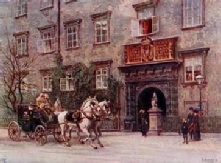


An old picture of the Academy
(picture: wikipedia)
The Academy in 2006
(picture: wikipedia)



To my regret, the art academy was renovated when I was there. Only one of the side doors was visible. (pictures: the Hitlerpages, 2019)
















































The hospital today (picture: the Hitlerpages, 2019)












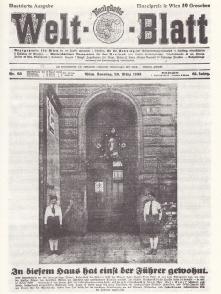


































A helpful source from Australia sent this picture of the hotel. Although it’s not longer used as a hotel, the name is still on the front wall of the building.
(picture: all rights reserved)
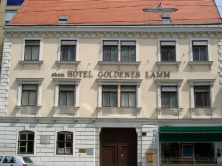

Nordwestbahnhof (21)
Location: Corner Nordwestbahnstraße/Taborstraße
Today: Bombed in 1945. The remains of the building are mostly gone. Plans to change the area have been made.
On April 9, 1938 Hitler held a speech at the Nordwestbahnhof, that wasn’t used as a station since 1924. Instead exhibitions and meetings took place there.
The Nordwestbahnhof in 1873
(picture: public domain, www.wikipedia.de)
The location today
(picture: www.wikipedia.de)

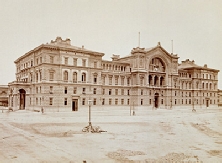
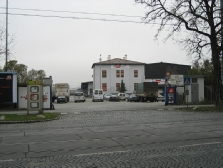
Westbahnhof (22)
Location: Europaplatz (Neubaugürtel)
Today: Still there
The trains from Linz arrived at the Westbahnhof, so when Hitler travelled from Linz to Vienna and back, he must have used this station. In July 1908, when Hitler’s friend August Kubizek left for Linz, Hitler and Kubizek said goodbye here. They didn’t see each other again until Hitler was Reichskanzler of Germany.
Left: The Westbahnhof in
Wien in 1895
(picture: en.wikipedia.org)
The new main building of the Westbahnhof was ready in 1952. This picture shows the station on the Europaplatz in 2007
(picture: de.wikipedia.org)
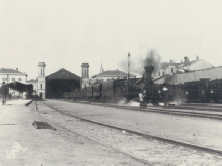

Karlsplatz -
Location: Karlsplatz. Other locations Hitler saw during this visit are unknown.
In May 1906 Hitler, who was 17 years old at that time, went to Vienna for the first time. Where he stayed at is unknown. He sent a postcard to his friend August Kubizek (stamped May 7 1906) with a picture of the Karlsplatz. Hitler marked the building of the Musikverein, because the Musicschool was there at that time. Kubizek studied there later. (Hamann, 1996)
The Musikverein
(picture: www.wikipedia.de)
Karlplatz
(picture: public domain, www.wikipedia.de)
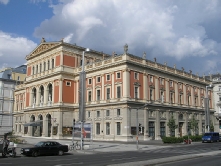

Stadttheater (24)
Location: Himmelpfortgasse 25
Today: The Stadttheater was called Wiener Stadttheater in 1871/1872. It burned down in 1884. A man called Anton Ronacher bought the building and turned it into a new Concert-
On May 7, 1906 Hitler probably went to the performance of the comedy Der Gwissenswurm. (A postcard he sent says he planned to go to there.)
A drawing of the Stadttheater in Wien in 1872
(picture: public domain; de.wikipedia.org)
The Ronacher in 2006
(picture: de.wikipedia.org)
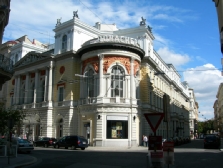
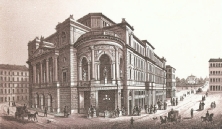
Prater (36)
Location: Between the Ausstellungsstrasse and the Hauptallee. The Prater Museum is located at the Hauptallee.
Today: The amusement park (Wurstel)Prater was destroyed in 1945. A renovation of the park took place in 2004.
Hitler and Kubizek went to the Prater area at least once. Hitler didn’t understand the laughing, dancing and drinking people. On October 9, 1920 Hitler held a speech at the Prater.
The Hauptallee
(picture: public domain, en.wikipedia.org)
The Prater as seen from the ‘Riesenrad’ (picture: en.wikipedia.org)

The Prater entrance building (picture: the Hitlerpages, 2019)


Caféhaus Kaiserstrasse (29)
Location: Exact location unknown
In the period after September 1909 Hitler said he spent some nights at a caféhaus in the Kaiserstrasse until he was out of money. After that he must have slept some nights on benches in the park.
Wärmestube of Baron Königswarter (30)
Location: Somewhere in the area of Erdberg
Today: Unknown
In the autumn and winter 1909/1910, Hitler stayed at different homeless shelters. In Meidlingen, the area of Favoriten and in Erdberg. The baron Königswarter had a so called Wärmestube there, that was open all night. The information about this period, comes from Reinhold Hanisch (Hamann, 1998).
Wimberger Saal (31)
Location: Neubaugürtel 34-
Today: Arcotel Wimberger, the restaurants interior dates from 1871
Hitler was present at several meetings of the Deutschnationalen to hear Karl Hermann Wolfs speak. When Wolfs died. he was burried in 1941 in an ‘Ehrengrab’ at the Zentralfriedhof in Vienna (17).
Spinnerin am Kreuz
Location: Wien-
Today: Still there
According to August Kubizek, Hitler took his friend (Kubizek) to see the Spinnerin am Kreuz. Going there Hitler made remarks about the Italian talking workers that walk past them. Hitler must have said: ‘Da hast du dein deutsches Wien.’ Kubizek told more about Hitler's irritation about foreign languages in Wien, for instance when they heared ‘Tchechisch’ in area’s of Rudolfsheim, Fünfhaus or Ottakring. (Hamman, 1998)
The Spinnerin am Kreuz on the Triester Strasse
(picture: www.wikipedia.de)
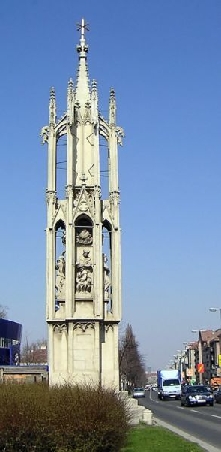
House of family Jahoda (33)
Location: Grinzinger Straße 86 (corner Grinzinger Strasse and Heiligenstädter Straße)
Today: The house is not longer there and the numbering in the street has changed.
On evenings the Jewish family Jahoda spent on making and listening to music, they often invited students of the Music Academy. Hitler's friend August Kubizek came there every once in a while. He took Hitler there once. He must have liked it there very much, and the library of Dr. Jahoda seems to have impressed him.
Store of Samuel Morgenstern (34)
Location: Liechtensteinstrasse 4
Today: The store has gone, not sure about the building.
Hitler sold his drawings at this address. He (himself, and not Hanisch) came here for the first time in 1911/1912 to sell three pictures. Morgenstern sold several pictures that Hitler made.
Haus of Rudolf Häusler (35)
Location: Döblinger Sommergasse
Today: Unknown
Hitler met Rudolf Häusler at the Männerheim at the Meldemannstrasse in 1913. He was the black sheep of his family (Hamann, 1998). He failed at school and he got thrown out of his parents house by his father. He visited his mother when his father was not at home. He took Adolf Hitler with him sometimes.
Ratzenstadl -
Location: Ratzenstadl is the area of the Gumpendorfer Strasse, the Windmühlgasse and the river
Today: The scene Hitler drew has been painted a lot, but I don’t know if the exact location is still there.
Hitler made a drawing called Alt Wien, Ratzenstadl.
A drawing Hitler made of Ratzenstadl (Joachimsthaler, 1989)
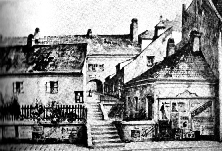
Peterskirche (38)
Location: Petersplatz
Today: The church is still there.
A drawing that Hitler made of the Peterskirche still existst.
Hitler's impression of the Peterskirche



Hitler's last visit to Vienna in 1941
Route: Stadtkern – Parliament (4) – Oper (5) – Schwarzenberg-
On Hitler's last visit to Vienna, Hitler did a tour through the city by car.
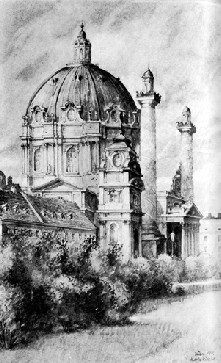
The Stephansdom on the Stephansplatz
(picture: commons.wikipedia.org)
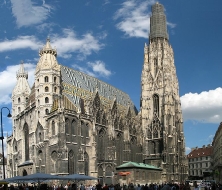
The Minoritenkirche at the Minoritenplatz
(picture: commons.wikipedia.org)
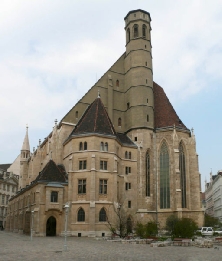
Franziskanerplatz -
Location: Franziskanerplatz
Today: Still very much the same
In 1912 Hitler mad e a drawing of the Franziskanerplatz.
Hitler's drawing of the Franziskanerplatz (left) and a recent picture of the church (picture: Strajan)
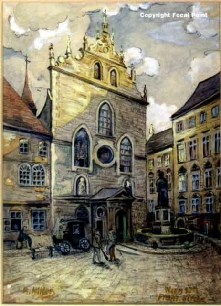

Address Paula Wolf (43)
Location: Gersthoferstraße 26
Today: Children’s clothes shop Tom & Jerry Kindermoden has a store on this address.
Adolf Hitler’s sister, Paula, lived here in the 30’s. As far as I know Adolf Hitler never came here.
Paula Hitler
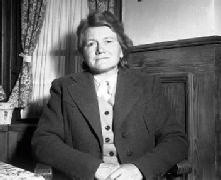
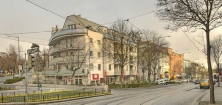
Gersthoferstraße 30, number 26 (today) is located in the orange building behind it.
Store Samuel Morgenstern (44)
Location: Liechtensteinstraße 4
Today: A new building of the Östereichische Volksbank is being built here.
Adolf Hitler sold drawings of himself to different Jewish shop owners. He, for instance, sold several drawings to Samuel (and Emma) Morgenstern, who had a shop on the Liechtensteinstraße. (source: Hamann, 2008)
Branntweiners (45)
Location: Webgasse 20
Today: Not longer there. Not sure if the building is still the same.
When Hitler lived at the Stumpergasse he often went to the small café Branntweiners of the Jewish owner Jakob Wasserberg. He often drank tea and ate a cheap cake, a so called Laberl. (source: Hamann, 2008)
Alte Rathaus (46)
Location: Wipplingerstrasse 8
Today: Still there. The building houses the Bezirksmuseum Innere Stadt, Dokumentationsarchiv de österreichischen Widerstandes and the Magistratische Bezirksamt now.
On December 28, 1921 Adolf Hitler was a guest speaker at a meeting in the Alten Rathaus in Viennna of ‘Grossdeutsche’, ‘Nationalsozialistische’ and ‘Völkische Parteien’ who were against the treaty of Prag/Lana, that was signed on December 16, 1921 by the Austrian Bundeskanzler Schober with Czechoslovakia. (source: Johann Auer, Institut für Zeitgeschichte, Vierteljahrshefte für Zeitgeschichte, Jahrgang 14 (1966) Heft 2)
Café Kubata (..)
Location: Schwegerstrasse 25
Today: There’s still a buidling there.
It is said that Hitler came here often and that the owner, Maria Wohlrab used the serve large portions of food. It is also said that Hitler liked a young woman that worked here with the name of Marie Rinke. (source: Jones, Hitler in Vienna, pp. 242-
A drawing of the Karlskirche Hitler made himself